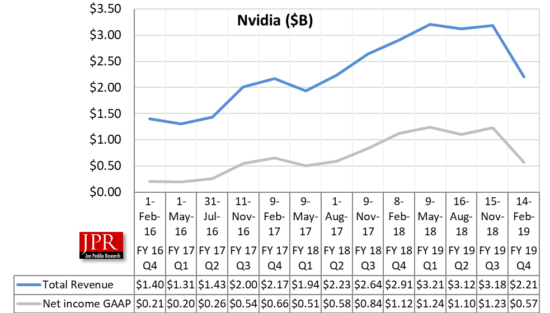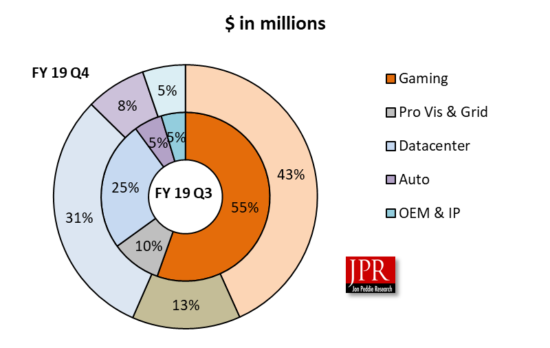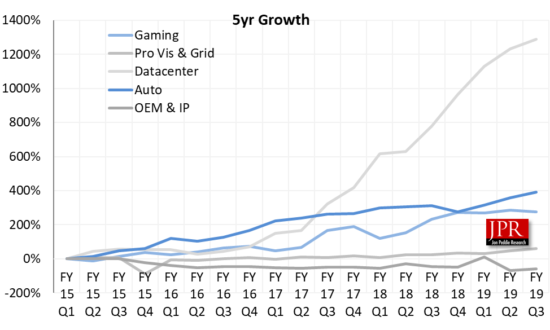$2.1 billion in sales, $567 million profit down 54% from last quarter.
Nvidia reported revenue from most platforms—Gaming, Datacenter, Professional Visualization, and Automotive saw a decline.
The company’s GPU business revenue was $1.98 billion, down 19.5% from a year earlier and down 28.6% sequentially.
Revenue was down 24% year over year and down 31% sequentially, driven primarily by a decline in Gaming. Full-year revenue was up 21%, reflecting growth in each of our market platforms.
“This was a turbulent close to what had been a great year,” said Jensen Huang, founder and CEO of Nvidia. “The combination of post-crypto excess channel inventory and recent deteriorating end-market conditions drove a disappointing quarter.
 Nvidia said, GAAP gross margin for the fourth quarter was 54.7% and non-GAAP gross margin was 56.0%. Gross margins decreased year-on-year and, sequentially, reflecting the impact of approximately $128 million in charges for excess DRAM, boards, and other components.
Nvidia said, GAAP gross margin for the fourth quarter was 54.7% and non-GAAP gross margin was 56.0%. Gross margins decreased year-on-year and, sequentially, reflecting the impact of approximately $128 million in charges for excess DRAM, boards, and other components.
GPU business revenue was $1.98 billion, down 20% from a year earlier and down 29% sequentially, primarily reflecting declines in gaming GPUs.
Tegra Processor business revenue—which includes Automotive, SOC modules for gaming platforms, and embedded edge AI platforms—was $225 million, down 50% from a year ago and down 45% sequentially, primarily reflecting a decline in shipments of SOC modules for gaming platforms.
Gaming revenue was $954 million, down 45% from a year ago and down 46% sequentially, driven by weakness in gaming GPUs and a decline in shipments of SOC modules for gaming platforms.
Professional Visualization revenue was $293 million, up 15% from a year earlier and down 4% sequentially. The year-on-year increase reflects strength across both desktop and mobile workstation products.
Datacenter revenue was $679 million, up 12% from a year ago and down 14% sequentially. The year-on-year increase primarily reflects growth in sales of Volta architecture products, including Nvidia Tesla V100 and DGX systems. The sequential decline reflects a broad-based slowdown across our customers.
Automotive revenue was $163 million, up 23% from a year earlier and down 5% sequentially. The year-on-year increase reflects growth in infotainment modules, production Drive platforms, and development agreements with automotive companies.
OEM and IP revenues were $116 million, down 36% from a year ago and down 22% sequentially. The year-on-year decrease is primarily due to the absence of crypto-currency mining GPU sales. The sequential decrease reflects a decline in shipments of legacy notebook products.
In fiscal 2019, Nvidia returned $1.95 billion to shareholders through a combination of $1.58 billion in share repurchases and $371 million in quarterly cash dividends.
Of the $3.00 billion, Nvidia intends to return to shareholders by the end of fiscal 2020, $700 million in share repurchases were completed in the fourth quarter of fiscal 2019. The company intends to return the remaining $2.30 billion by the end of fiscal 2020, through a combination of share repurchases and cash dividends.
Nvidia will pay its next quarterly cash dividend of $0.16 per share on March 22, 2019, to all shareholders of record on March 1, 2019.

During the quarter, Nvidia announced it had launched the GeForce RTX 2060 GPU, unveiled a record 40+ new gaming laptops in over 100 configurations powered by GeForce RTX GPUs, and announced that Battlefield V, the first realtime ray tracing game, will add DLSS AI super-sampling technology; that the highly anticipated game Anthem will integrate DLSS; and that Justice, one of China’s most popular MMO games, will add ray tracing and DLSS.
The company also introduced the Quadro RTX 4000 bringing ray tracing to workstations.
Outlook
The company’s outlook for the first quarter of fiscal 2020 is as follows:
- Revenue is expected to be $2.20 billion, plus or minus two percent.
- GAAP and non-GAAP gross margins are expected to be 58.8% and 59.0%, respectively, plus or minus 50 basis points.
- GAAP and non-GAAP operating expenses are expected to be approximately $930 million and $755 million respectively. The sequential change in GAAP operating expenses reflects an increase in stock-based compensation.
- GAAP and non-GAAP other income and expense are both expected to be income of approximately $20 million.
- GAAP and non-GAAP tax rates are both expected to be 10%, plus or minus one percent, excluding any discrete items. GAAP discrete items include excess tax benefits or deficiencies related to stock based compensation, which are expected to generate variability on a quarter by quarter basis.
- Capital expenditures are expected to be approximately $150 million to $170 million.
For fiscal 2020, revenue is expected to be flat to down slightly.
What do we think?
Even though the quarter was down significantly, and gaming took the biggest hit (-46% Q-Q, 45% Y-Y), it is still the big money maker for Nvidia as shown in the following chart, with growth and higher ASPs coming from the pro viz and datacenter.

In addition to getting a clean sweep of all the laptop builders, Nvidia has also gotten 90% of all the independent game engine developers. Unreal Engine was the first, showing storm troopers in ray tracing glory. Now Nvidia’s CEO, Jensen Huang revealed that Unity too will be supporting ray tracing.
Furthermore, Huang said Nvidia is working with developers on every single game coming out to add ray tracing which means not only has the company gained support from the independent game engines, it has also gained support from all the captive in-house game engines as well. And, UL-Futuremark has added DLSS to its ray tracing benchmark.
However, Tegra sales are down 50% from a year ago and down 45% sequentially, primarily reflecting a decline in shipments of SOC modules for gaming platforms—i.e., Nintendo’s Switch sales. Tegra-based Switch can’t support ray tracing, not that would impact their sales.

The numeric values are shown in the following table.

Nvidia’s GPU revenue includes GeForce, Quadro, Tesla and OEM.
Gaming includes GeForce DT/NB, and Nintendo Switch. Other products such as GeForce Now, and G-SYNC are included in with its gaming revenue as well.
The valuation placed on the company is quite high even after it reported third fiscal quarter earnings (ended October 28) that missed Wall Street’s targets Nvidia saw its stock price fall 15% in after-hours trading. However, after reporting its FY Q4 fiscal results which were disappointing, its share price went up because the results weren’t as bad as some investors thought they would be.

Nvidia’s launch of its Turing GPU architecture, which the company says is its most important innovation since the invention of the single chip GPU more than a decade ago, hasn’t added the lift some expected. The company needs to get more game developers to adopt the RTX and DLSS technology to get the gamers excited.





